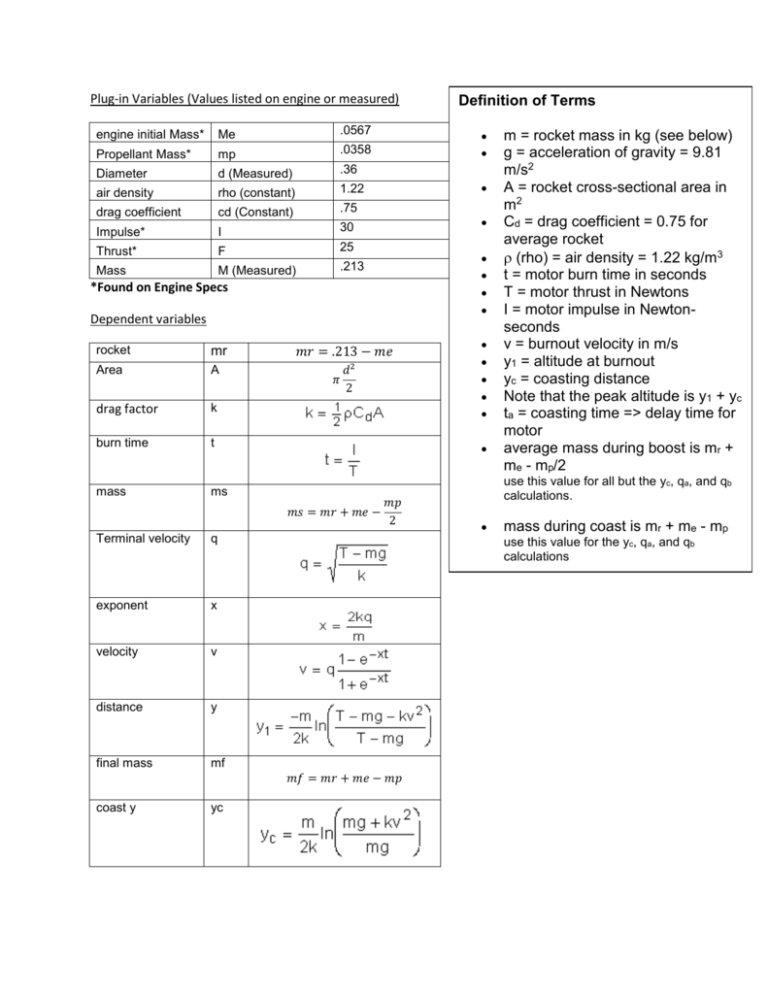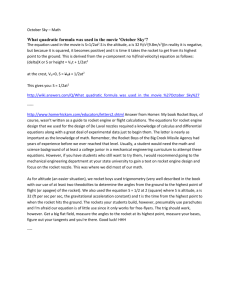rocket+Equations
advertisement

Plug-in Variables (Values listed on engine or measured) Me .0567 Propellant Mass* mp .0358 Diameter d (Measured) .36 air density rho (constant) 1.22 drag coefficient cd (Constant) .75 Impulse* I 30 Thrust* F 25 Mass M (Measured) .213 engine initial Mass* *Found on Engine Specs Dependent variables rocket mr Area A drag factor k burn time t mass ms 𝑚𝑟 = .213 − 𝑚𝑒 𝜋 𝑑2 2 q exponent x velocity v distance y final mass mf 𝑚𝑝 2 yc m = rocket mass in kg (see below) g = acceleration of gravity = 9.81 m/s2 A = rocket cross-sectional area in m2 Cd = drag coefficient = 0.75 for average rocket (rho) = air density = 1.22 kg/m3 t = motor burn time in seconds T = motor thrust in Newtons I = motor impulse in Newtonseconds v = burnout velocity in m/s y1 = altitude at burnout yc = coasting distance Note that the peak altitude is y1 + yc ta = coasting time => delay time for motor average mass during boost is mr + me - mp/2 use this value for all but the yc, qa, and qb calculations. mass during coast is mr + me - mp use this value for the yc, qa, and qb calculations 𝑚𝑓 = 𝑚𝑟 + 𝑚𝑒 − 𝑚𝑝 coast y 𝑚𝑠 = 𝑚𝑟 + 𝑚𝑒 − Terminal velocity Definition of Terms total y yt 𝑦𝑡 = 𝑦 + 𝑦𝑐 qa qb coast time ta Max Velocity vmph 𝑣𝑚𝑝ℎ = 2.237(𝑣) Max Altitude yfeet 𝑦𝑓𝑒𝑒𝑡 = 3.28(𝑦𝑡) Max Drag fd 𝑓𝑑 = 𝑘𝑣 2 𝑣𝑒𝑙𝑜𝑐𝑖𝑡𝑦 = 𝑞 23.5 − .406 ∗ 9.81 𝑞=√ = 130.9117 . 001139 𝑡= 1 − 𝑒 −𝑥𝑡 1 + 𝑒 −𝑥𝑡 𝑥= 𝑘 = 1.22 43.19 = 1.837872 𝑠𝑒𝑐𝑜𝑛𝑑𝑠 23.5 2 ∗ .001139 ∗ 130.9117 = .734416 . 406 𝑘𝑔 ∗ .75 ∗ 𝜋. 0281559 2 = .001139 𝑚3 23.5−.406(9.81) 2(.001139)√ 𝑘𝑔 1.22 3 ∗.75∗𝜋(.0281559)2 43.19 𝑚 − .406 23.5 𝑣=√ 23.5 − .406(9.81) 1 − 𝑒( ( 𝑘𝑔 1.22 3 ∗ .75 ∗ 𝜋(.0281559)2 𝑚 ) 23.5−.406(9.81) 2(.001139)√ 𝑘𝑔 1.22 3 ∗.75∗𝜋(.0281559)2 43.19 𝑚 − .406 23.5 1 + 𝑒( 𝑣𝑒𝑙𝑜𝑐𝑖𝑡𝑦 = 76.82 𝑚/𝑠 ) Calculus Behind Equations: Altitude of Rocket when engine burns out (VDBP): 𝑣𝑒𝑟𝑡𝑖𝑐𝑎𝑙 𝑑𝑖𝑠𝑝𝑙𝑎𝑐𝑒𝑚𝑒𝑛𝑡 𝑏𝑜𝑜𝑠𝑡 𝑝𝑜𝑟𝑡𝑖𝑜𝑛 (𝑉𝐷𝐵𝑃) −𝑚 𝑇 − 𝑚𝑔 − 𝑘𝑣 2 = ln( ) 2𝑘 𝑇 − 𝑚𝑔 𝑣𝑒𝑟𝑡𝑖𝑐𝑎𝑙 𝑑𝑖𝑠𝑝𝑙𝑎𝑐𝑒𝑚𝑒𝑛𝑡 𝑐𝑜𝑎𝑠𝑡 𝑝𝑜𝑟𝑡𝑖𝑜𝑛 (𝑉𝐷𝐶𝑃) 𝑚 𝑚𝑔 + 𝑘𝑣 2 = ln( ) 2𝑘 𝑚𝑔 Coast Altitude (VDCP): 𝑚 𝑚𝑔 + (𝑟ℎ𝑜 ∗ 𝐶𝑑 ∗ 𝜋𝑟 2 )𝑣 2 ln( ) 2(𝑟ℎ𝑜 ∗ 𝐶𝑑 ∗ 𝜋𝑟 2 ) 𝑚𝑔 −𝑚 𝑇 − 𝑚𝑔 − (𝑟ℎ𝑜 ∗ 𝐶𝑑 ∗ 𝜋𝑟 2 )𝑣 2 + ln( ) 2(𝑟ℎ𝑜 ∗ 𝐶𝑑 ∗ 𝜋𝑟 2 ) 𝑇 − 𝑚𝑔 = 𝑡𝑜𝑡𝑎𝑙 ℎ𝑒𝑖𝑔ℎ𝑡 . 213 . 213(9.8) + (1.22 ∗ .75 ∗ 3.14(.36)2 )76.822 ln( ) 2(1.22 ∗ .75 ∗ 3.14(. 36)2 ) 𝑚𝑔 −.213 1 − .213(9.8) − (1.22 ∗ .75 ∗ 3.14(.36)2 )𝑣76.822 + ln( ) = 606 𝑓𝑒𝑒𝑡 2(1.22 ∗ .75 ∗ 3.14(. 36)2 ) 1 − .213(9.8) Mathematical and Scientific Principles behind our Rocket: The laws of rocketry are quite simple. They are the incarnation of Newton’s third law of motion. For every action there is an equal and opposite reaction. By firing an engine and releasing lots of energy downward an equal and opposite force pushes the rocket upward—propelling it into the sky. This is the foundation of rocketry. Newton helps us again, though, with his first law, stating that an object in motion remains in motion and an object at rest stays at rest unless acted on by another force. This helps our rocket gain altitude during the coast time until gravity is able to pull it down towards Earth. Furthermore, his second law, stating that a force is created by an acceleration occurring on a mass, is determined by the overall weight of our rocket and the size of the motor. If we performed a launch within a vacuum these variables would be the only factors to raise the rocket 750 feet. We would just need to calculate the force needed to pull a rocket precisely that distance against gravity before tumbling down. However, the world is a bit more complicated than that and we need to take into account wind resistance, and rocket stability. The stability of a rocket is determined by having a higher center of mass than a center of surface area. This makes the rocket require more torsion to spin and this is good because the less spinning the better the rocket will perform. Any spinning of the rocket creates an angle that shoots the rocket slightly lower. The way to account for one’s stability is to account for payload placement and to guage fin size accordingly. The trick of picking the correct fins is a balance between weight and surface area required to make the rocket stable. There is also air resistance which is countered by using aerodynamic designs such as a nose cone and by using a sealing coat of paint to lower the air resistance as much as possible. Less friction is less opposing force on the rocket allowing it to rise even higher.








